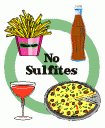I recently came across an article discussing Sulfites. Sulfites (AKA Sulfur dioxide or SO2) are a common topic as they relate to wine. I have met many people who believe they are allergic to sulfites or get headaches from them. I have also heard claims that white wine or organic wine does not contain sulfites. Both not true – although organic can contain lower levels of sulfites than other wines. Sulfites are added to wine to protect against oxidation, and are used at varying levels be different winemakers. And yes, there are many who try to add as little as possible.

The article, written for the SF Chronicle, contains some stories about winemakers adding as little SO2 as possible. But what I found most interesting were the following sections…
“Sulfites are present in all wines both as an additive and as a natural by-product of fermentation, and many countries require that their presence be indicated on the label.”
“Sulfur dioxide has been used in the production of wine for centuries – primarily as a buffer to keep wine from reacting with too much oxygen, but also to inhibit microbial spoilage (from bacteria or rogue yeasts) that could lead to off flavors and aromas, and as a winemaking technique to partly control fermentation. It’s is one of the most useful and powerful tools available to a winemaker.”
How and why sulfites are used in wine
1. At the crusher: Sulfur dioxide in the form of a diluted liquid solution is added to just-harvested grapes at the crusher to protect against oxidation. Much of the sulfur added at this stage is effectively used up during the subsequent fermentation, converting into what is referred to as “bound” form, which has almost no flavor.
2. Barrel cleaning and maintenance: Sulfur dioxide was once the primary agent used to clean barrels and larger wooden vessels like puncheons or upright fermentation tanks; in the 19th century, this was accomplished by burning a sulfur wick, which released SO{-2} gas. Today, while other techniques are used in the cleaning process, winemakers often use a gas form of sulfur dioxide to maintain a sterile environment inside of wooden containers after cleaning.
3. In the winery: Sulfur dioxide is often used when topping up barrels that have lost some volume of wine through evaporation. There is a chance that microbial spoilage can occur at this point, so sulfur dioxide (as a diluted liquid solution) may be added as a preventative measure. Additionally, low levels of sulfur dioxide will protect against oxidation in the barrel.
4. During bottling: The bottling process can be rough on a wine, and there is the chance of overexposure to oxygen. Winemakers will often dose a wine with sulfur dioxide solution just prior to bottling in order to keep it in a reductive state, protected against oxidation. This SO{-2} should dissipate over time, although traces can remain present for longer periods in wines bottled under less breathable enclosures, like screwcaps.
Debunking myths
There are several widespread myths about sulfur dioxide – and sulfites in general. Here are some explanations that should help you to finally avoid that headache in the morning:
Sulfites in red wine cause headaches. While it’s true that exposure to high levels of SO{-2} is an unpleasant experience, there’s no hard evidence that proves sulfites and SO{-2} cause migraines in red wine drinkers. A phenomenon often called “red wine headache” is a combination of several things, with histamines considered one likely major factor. High levels of alcohol and residual sugar are also far more likely culprits than sulfites. When it comes to the negative effects of sulfites, asthmatics are the most vulnerable and need to closely monitor their intake of sulfites – or avoid them altogether. It’s worth noting though, that many foods – dried fruit, for instance – contain higher levels of sulfites than wine. Allergic reactions to sulfites include far more severe symptoms than headaches, like hives and anaphylactic shock.
Red wines contain more sulfites than white wines. The higher levels of tannin in red wines mean winemakers use less total SO{-2} in red wines than in whites. Sulfur dioxide is sometimes used to halt fermentation for wines that will be sweet, including many German Rieslings. Dessert wines, because of their high levels of residual sugar, have even greater levels of added sulfur.
Organic wines don’t contain sulfites. It is impossible to produce a wine without any sulfites, as sulfur dioxide is a naturally occurring by-product of fermentation. Therefore, even wines with zero added SO{-2}, such as natural and organic wines from the United States and Europe, contain small amounts of the compound.
The entire article is an interesting read for those of you who are wine curious enough.
Happy minimally added sulfur wine tasting!
WTG





